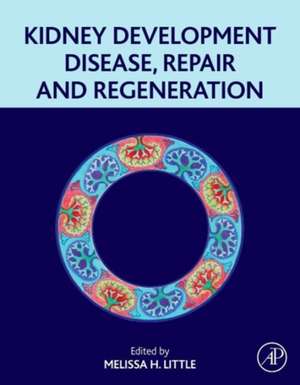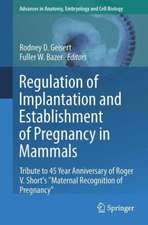Kidney Development, Disease, Repair and Regeneration
Editat de Melissa Helen Littleen Limba Engleză Hardback – 9 oct 2015
- Offers researchers a single comprehensive resource written by leaders from both the developmental biology and the experimental nephrology communities
- Focuses on understanding the molecular basis of organogenesis in the kidney as well as how this can be affected both genetically and environmentally
- Explains the underlying developmental mechanisms which influence the kidney’s inherent repair capacity
- Demonstrates how a deeper understanding of mechanisms will lead to greater advances in regenerative medicine
Preț: 668.20 lei
Preț vechi: 856.66 lei
-22% Nou
Puncte Express: 1002
Preț estimativ în valută:
127.88€ • 133.01$ • 105.57£
127.88€ • 133.01$ • 105.57£
Carte tipărită la comandă
Livrare economică 07-21 aprilie
Preluare comenzi: 021 569.72.76
Specificații
ISBN-13: 9780128001028
ISBN-10: 012800102X
Pagini: 614
Dimensiuni: 216 x 276 x 33 mm
Greutate: 1.86 kg
Editura: ELSEVIER SCIENCE
ISBN-10: 012800102X
Pagini: 614
Dimensiuni: 216 x 276 x 33 mm
Greutate: 1.86 kg
Editura: ELSEVIER SCIENCE
Cuprins
Section 1: Development
Development - Introduction
1. Zebrafish renal development and regeneration
2. Early specification and patterning of the intermediate mesoderm: genetics and epigenetics
3. The human kidney: parallels in structure, spatial development and timing of nephrogenesis
4. Growth factor signalling in UB branching
5. Quantification of branching morphogenesis
6. Transcriptional regulation of the nephrogenic mesenchyme and its progeny
7. The role of growth factors in balancing cap mesenchyme survival and differentiation
8. Notch signalling in nephron segmentation
9. Genetic and epigenetic regulation of nephron number in the human
10. Formation and maintenance of a functional glomerulus
11. Maturation and roles of collecting ducts and loops of Henle in renal medulla development
12. Balancing self-renewal and differentiation: the role of the stroma
13. The origin and regulation of the renal vasculature
Section 2: Disease
Disease - Introduction
14. Variation in nephron number and association with disease.
15. The effect of the in utero environment on nephrogenesis and renal function
16. Persistence of the nephrogenic mesenchyme in disease: the role of WT1
17. Wnts, Notch and tubular pathology
18. Regulation of ureteric bud outgrowth and the consequences of disrupted development
19. Abnormal ureter-bladder connections are associated
20. Polycystic kidney disease: underlying causes, consequences and variation between mouse and man.
21. Genetic aspects of human congenital anomalies of kidney and urinary tract
22. Inherited kidney disorders in the age of genomics
23. Fibrosis: a failure of normal repair and a common pathway to organ failure
Section 3: Repair
Repair - Introduction
24. Postnatal cell turnover in the nephron epithelium: what can this tell us
25. Plasticity within the collecting ducts: what role does this play in response to injury
26. The onset and resolution of renal fibrosis: a human perspective
27. Chronic renal damage: how does this suppress normal repair processes
28. Investigating the process of renal epithelial repair to develop new therapies
29. Evidence for renal progenitors in the human kidney
30. The papilla as a source of kidney progenitors
31. A positive role for the macrophage in renal repair
32. The use of MSCs for treating acute renal injury and modulating rejection
Section 4: Regeneration
Regeneration - Introduction
33. Reprogramming to the nephron progenitor state
34. From development to regeneration: kidney reconstitution in vitro and in vivo.
35. Directing the differentiation of pluripotent cells to renal endpoints
36. Patient-derived iPS cells: what can they teach us?
37. Xenotransplantation in the kidney: an historical perspective
38. The use of the nephrogenic niche of a xeno-embryo for commitment to kidney
39. Human fetal kidneys for renal regenerative medicine: from rudiments to nephron stem/progenitor cells
40. Renal replacement approaches using deceased donor sources
41. Tissue Engineering through Additive Manufacturing: Hope for a bioengineered kidney?
42. Decellularised scaffolds for the recreation of organs
Development - Introduction
1. Zebrafish renal development and regeneration
2. Early specification and patterning of the intermediate mesoderm: genetics and epigenetics
3. The human kidney: parallels in structure, spatial development and timing of nephrogenesis
4. Growth factor signalling in UB branching
5. Quantification of branching morphogenesis
6. Transcriptional regulation of the nephrogenic mesenchyme and its progeny
7. The role of growth factors in balancing cap mesenchyme survival and differentiation
8. Notch signalling in nephron segmentation
9. Genetic and epigenetic regulation of nephron number in the human
10. Formation and maintenance of a functional glomerulus
11. Maturation and roles of collecting ducts and loops of Henle in renal medulla development
12. Balancing self-renewal and differentiation: the role of the stroma
13. The origin and regulation of the renal vasculature
Section 2: Disease
Disease - Introduction
14. Variation in nephron number and association with disease.
15. The effect of the in utero environment on nephrogenesis and renal function
16. Persistence of the nephrogenic mesenchyme in disease: the role of WT1
17. Wnts, Notch and tubular pathology
18. Regulation of ureteric bud outgrowth and the consequences of disrupted development
19. Abnormal ureter-bladder connections are associated
20. Polycystic kidney disease: underlying causes, consequences and variation between mouse and man.
21. Genetic aspects of human congenital anomalies of kidney and urinary tract
22. Inherited kidney disorders in the age of genomics
23. Fibrosis: a failure of normal repair and a common pathway to organ failure
Section 3: Repair
Repair - Introduction
24. Postnatal cell turnover in the nephron epithelium: what can this tell us
25. Plasticity within the collecting ducts: what role does this play in response to injury
26. The onset and resolution of renal fibrosis: a human perspective
27. Chronic renal damage: how does this suppress normal repair processes
28. Investigating the process of renal epithelial repair to develop new therapies
29. Evidence for renal progenitors in the human kidney
30. The papilla as a source of kidney progenitors
31. A positive role for the macrophage in renal repair
32. The use of MSCs for treating acute renal injury and modulating rejection
Section 4: Regeneration
Regeneration - Introduction
33. Reprogramming to the nephron progenitor state
34. From development to regeneration: kidney reconstitution in vitro and in vivo.
35. Directing the differentiation of pluripotent cells to renal endpoints
36. Patient-derived iPS cells: what can they teach us?
37. Xenotransplantation in the kidney: an historical perspective
38. The use of the nephrogenic niche of a xeno-embryo for commitment to kidney
39. Human fetal kidneys for renal regenerative medicine: from rudiments to nephron stem/progenitor cells
40. Renal replacement approaches using deceased donor sources
41. Tissue Engineering through Additive Manufacturing: Hope for a bioengineered kidney?
42. Decellularised scaffolds for the recreation of organs






















